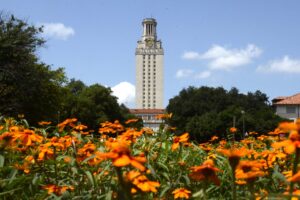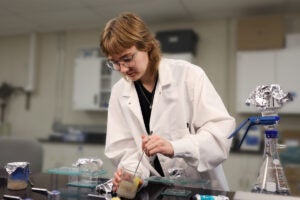AUSTIN, Texas—Researchers from The University of Texas at Austin’s Institute for Geophysics (UTIG) and the Massachusetts Institute of Technology (MIT) recently led a team of 28 scientists representing eight countries on an expedition on which they discovered a large underwater plateau in the Indian Ocean that once was a small continent above sea level.
The landmass is located in the remote and turbulent waters of the southern Indian Ocean straddling the Antarctic Polar Front, according to Dr. Mike Coffin of UTIG and Fred Frey of MIT. The researchers found evidence that the Kerguelen plateau they are studying had existed as a large landmass above sea level at three different times during an 80-million year period, before finally becoming submerged about 20 million years ago.
Coffin and Frey are part of the Ocean Drilling Program (ODP) that mounted an expedition to study the Kerguelen plateau and its now separate feature, Broken Ridge. Their findings are soon to be published in Science magazine.
The mostly submarine Kerguelen plateau, which is one-third the size of the contiguous United States, is beneath an area of challenging winds and seas of the Kerguelen “Triangle,” where two Vendée Globe round-the-world racing yachts capsized in 1997. Scientists refer to the landmass as a “micro-continent” because of its smaller size in comparison with Earth’s better-known continents.
The Kerguelen plateau is one example of a unique type of Earth feature, a large igneous province (LIP). One of the least understood features in the ocean basins, LIPs are believed to be the surface manifestations of massive pulses of volcanism that originated deep within Earth’s mantle in association with narrow upwelling systems, known as mantle plumes or hotspots. The episodic nature of LIP eruptions documented in the geologic record, especially between 150 and 50 million years ago, is evidence that a more dynamic, unpredictable mode of mantle circulation, very different from that driving present-day plate motions, existed during Earth’s past. LIPs preserve a record of mantle dynamics and also may have affected the Earth’s environment in the past by potentially altering ocean circulation, climate conditions and sea level.
The Ocean Drilling Program (ODP), utilizing the drilling ship JOIDES Resolution, operated by Texas A&M University, set out to study the plateau’s eruption history by analyzing samples of sediment and lava collected from deep beneath the sea floor. Since its formation, the plateau has subsided to great water depths (1 to 2.5 km). Prior to Leg 183, Coffin and other UTIG researchers participated in three successful geophysical surveys on the Kerguelen Plateau undertaken by Australia (1997) and France (1998). The new site survey data from these cruises set the stage for ODP Leg 183 to the site in the southern Indian Ocean.
The earliest known volcanism associated with the Kerguelen hot spot began about 130 million years ago when Africa, Antarctica, Australia, India and Madagascar were just beginning to break apart, thus creating the Indian Ocean. Changing tectonic plate motions over the ensuing eons left a continuous record of the hot spot’s eruptive history, with peak volcanic events creating much of the Kerguelen Plateau and Broken Ridge. Leg 183 recovered volcanic rocks and interbedded sediments, which revealed two significant pulses of volcanism during Cretaceous time at about 110 and 85-95 million years. Subsequent plate motions over the Kerguelen plume resulted in the formation of the Ninetyeast Ridge (82-38 million years) and the northern Kerguelen Plateau about 35 million years ago. The Kerguelen hot spot continues to erupt today at Heard and McDonald islands, albeit at rates much lower than those of more than 80 million years ago.
Surprising evidence recovered on Leg 183 revealed that the Kerguelen plateau had existed as a large landmass above sea level at three different times during an 80-million year period, before finally become submerged about 20 million years ago. The evidence consists of dark brown sediment overlying subaerially erupted lava flows, charcoal and wood fragments in sediments overlying igneous rocks, and conglomerates, which formed from sediments deposited in river beds, interlayered with lava flows. The final stage of volcanism forming the Kerguelen LIP produced magmas rich with gases such as carbon dioxide, oxides of sulfur and water vapor, which may have caused global environmental change.
HISTORICAL BACKGROUND. During the late 1700s, many explorers were searching for a legendary large southern continent they called “Terra Australis,” which they believed to exist and which they were anxious to claim and colonize for the country for which they sailed.
Yves Joseph de Kerguélen-Trémarac discovered La France Australe (today’s Kerguelen island chain in the Indian Ocean just north of Antarctica) in 1772, and in that same year claimed this ‘southern motherland’ for France.
Upon returning home, his eloquent rhapsodizing to the reigning French monarch about Kerguélen’s superb agricultural and mineral potential resulted in the king dispatching three ships and 700 men to colonize Kerguelen in 1773. However, 699 pairs of eyes couldn’t lie. They saw only the tiny volcanic islands, but no massive continent as Kerguélen had claimed. (They had no way of knowing then that a small continent lay about two kilometers below the volcanic islands, and it would be 1999 before the land mass would be discovered by Coffin, Frey and other scientists on the research team.) Upon Kerguélen’s second homecoming to France, he was court-martialed, sentenced to 20 years in prison, and dismissed from the Navy for exaggerating his findings.
Another explorer, Capt. James Cook, later set sail, also in search of “Terra Australis,” but the landmass he discovered actually was a smaller continent now known as Australia.
The legendary “Terra Australis” continent eventually was discovered in the early 19th century.
It was located further south and it’s present-day name is Antarctica.
For additional information, contact Dr. Mike Coffin at (512) 471-0429, or Dr. Kathy Kelly Ellins, UTIG program manager, at (512) 232-3251. On Friday, May 28, Coffin will be attending a meeting in Vancouver, Canada, and can be reached at (604) 822-6052.



